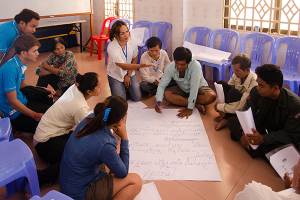Most integrated SBCC programs have broad health objectives (eg. improve maternal and neonatal health, increase contraceptive prevalence, reduce malaria-related mortality, etc.).
However, SBCC is about changing behaviors and practices. So, defining the priority health behaviors and practices to influence for each health area is an important first step. One way of going about this is to organize a short workshop among key stakeholders.
How to Conduct a Stakeholder Workshop
 Visit the Health COMpass to learn how to conduct a Stakeholder Workshop.
Visit the Health COMpass to learn how to conduct a Stakeholder Workshop.
This approach has the added value of building ownership for the SBCC program.
During the workshop, participants can work in small groups to define key behaviors and practices, and the priority population groups for each. They could also take it a step further to discuss the barriers and enabling factors for those priority population groups in practicing (or not practicing) the health behavior.
Sample Message Points per Health Area
The following messages from Malawi’s “Life is Precious” Communication Strategy were designed to address key behaviors selected based on findings from the formative research.
Family Planning
- Family planning methods are safe. If you have side effects, go to the clinic.
- Choose temporary or permanent family planning methods according to your needs.
- Pregnancy after the age of 35 puts a woman at greater risk.
- Getting pregnant when you are too young (younger than 18) puts your health and your baby's health at risk.
- Discuss with your partner on how best to plan your family.
- You have a right to decide when to get pregnant.
- Make healthy choices as a couple. Talk about family planning.
- Real men talk to their spouses about family planning.
Maternal, Neonatal and Child Health
- It is important to plan carefully for child birth and have a birth plan that includes when to go to the clinic, how to get there and the resources that will be needed during that period. Having a birth preparedness plan will help ensure a healthy outcome for your pregnancy and delivery.
- All couples should learn about, and know the danger signs of pregnancy, delivery and after delivery.
- Pregnant women should attend ANC at least four times before delivery and once within the first three months of pregnancy.
- Pregnant women should deliver at the health center for safe and skilled delivery.
- All children should be fully immunized by the age of one year.
- Parents should take their under-five children to the health facility as soon as they observe any danger sign.
Nutrition
- Eat foods from the six food groups - plant proteins, animal proteins, carbohydrates, fats and oils, minerals and vitamins - to stay strong and healthy.
- Pregnant and breastfeeding women need more food. Pregnant women should eat one extra meal per day, while breastfeeding women should eat two extra meals per day.
- Breastfeed your baby exclusively for the first six months.
Malaria
- Anyone can get malaria. Sleep under a long-lasting insecticide-treated net (LLIN) every night, all year round to protect yourself.
- Everyone in the family should sleep under the LLIN.
- Long-lasting insecticide-treated bed nets are safe for everyone in the family.
- Visit the nearest health center as soon as you notice fever in any family member (within 24 hours).
- Make sure to take all your malaria drugs as prescribed at the health center.
- Keep surroundings clean and dry to prevent mosquitoes from breeding.
HIV/AIDS
- If you do not know your status, you cannot get treatment. Get tested for HIV, get treated.
- Sexually transmitted infections (STIs) predispose you to HIV infection. Seek early treatment for STIs.
- Unprotected sex puts you at risk of HIV infection. Use condoms each time, every time.
- Partners who stay faithful to each other greatly reduce their risk of HIV infection.
- HIV-positive mothers can give birth to HIV-negative babies. Find out how at the health center.
- Talk to your partner about HIV and your options to protect each other. Take the test together.
WASH
- Leftover food should be covered properly and re-heated before eating to avoid disease.
- Wash your hands with clean water and soap/ash before preparing or eating meals, after visiting the toilet and after changing baby nappies.
- Drink only clean and safe water. Make water safe by boiling, or by treating with chlorine or other treatment agents.
- Avoid open defecation to prevent disease.

